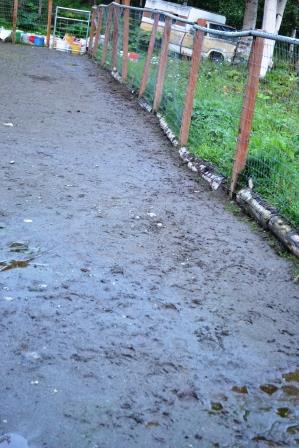
Home > Dispatches > Daily Dispatches 2014 > Daily Dispatch #188
July 10, 2014: Horse and Horse Facility Maintenance
I have come to the conclusion that horse ownership is three-quarters maintenance and one quarter riding; this is in terms of time spent on both. I suppose that people who board don’t spend as much time doing maintenance, but they must have to clean tack. How long could that take? For sure, they get the good bits. Admittedly, those who board do pay the price in that they work to pay the bills. So the labor in such instances is indirect and takes a differing form. On site horse ownership is extremely time-consuming. Like most, I feed, water, and clean up after our three Icelandic horses. Feed must be purchased and brought home. We are off the grid, so I harvest rain water. This also takes time, as does dealing with an always steady supply of fresh manure. Right now we have several full buckets, which will need to be given to someone. |
|
| And it’s now time to turn the manure/compost in the two stations. Come winter, I will haul the manure in the sled up behind the hoop house. I additionally clean tack several times a year, and as well, my two tack rooms. (One is a shed, and the other is the front part of my trailer.) Our horses live in a large paddock. We store the hay in two adjoining sheds, and in a third adjacent shed. The horses hang out in the center area of the former. The shed walls are covered with board and batten. I’m constantly on the lookout for protruding nails. For the past three weeks, Pete and I have been working on a fence-related chore. The wire mesh fencing that surrounds the paddock is at the bottom held in place with a cable. This is because the horses, in their haste to get at the greener grass on the other side of the fence, have bent the wire mesh and cable upward. This is dangerous. The horses could easily cut their noses on the wire. A few years back we got a few logs and put them at the base of the fence. We dug trenches, put the logs in the trenches, stapled the fence to the log, and then covered the log with the dirt that was previously in the trench. We did just a few, then went back to work on other projects. We recently realized that we’d have to do more. We drove Sputnik, our pickup truck, over to Murphy Road, and there we cut and loaded up sixteen fairly lengthy cottonwood logs that had been cut down by a neighbor. We then brought them home, and piled them next to the fence. Again, we resumed digging trenches, putting logs in trenches, stapling the fence to the log, and covering the logs with dirt that was previously in the trenches. The log count at this point in time is 16. This is such a mind numbing, tedious task that Pete and I have been doing just a few logs a day. However, the light is now at the end of the tunnel. We are moving right along, and in fact, we have a system. We both know what needs to be done, so when one of us is doing one thing, like stapling the log to the wire, the other is filling in the hole, using the dirt that minutes before came out of the hole. We got three logs into the ground today. We would have gotten more done, but we took time out and went for a ride. It was a good one. We rode the lower trail system and then went down Murphy Road a ways. I practiced horsemanship stuff with Raudi, in preparation for the upcoming competitive trail ride. She did extremely well – we are both very ready for this upcoming event. I often think of how different Pete and my lives would be if we were to board our horses. I suspect that out of sight, out of mind would often prevail. And I seriously doubt that they’d be as well cared for elsewhere as they are here. If they were in a place where they were well cared for, the boarding price would be off the charts. I’m glad our horses are here. It’s work, tending to them, but it’s work that I enjoy. Next: 189. 7/11/14: Horse Training: Hrimfara and Lessons Learned |
|
